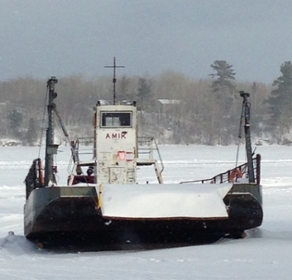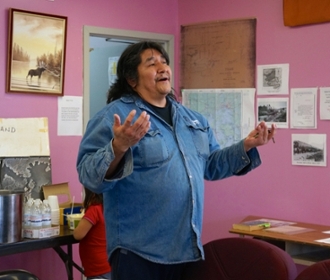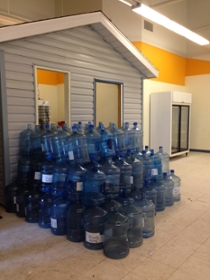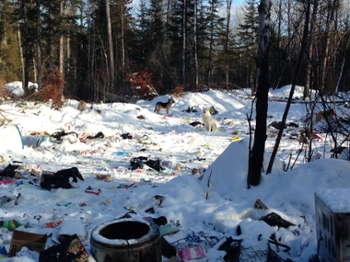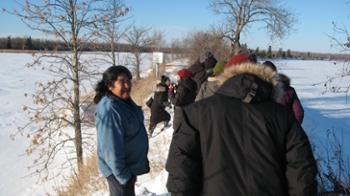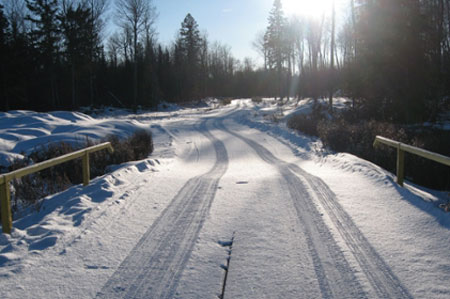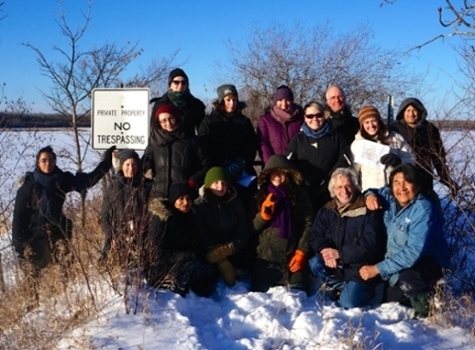Shoal Lake 40's Living Museum: A Photo Essay
July 23, 2015
Straddling the Manitoba-Ontario border, Shoal Lake 40 First Nation has existed as an artificial island for a hundred years since the City of Winnipeg built a 155-kilometre aqueduct to transport water from its lake to supply the provincial capital.
Completed in 1919, the aqueduct pushed the Anishinaabe nation off their traditional territory at the mouth of the Falcon River. The federal government unilaterally took their reserve land and the lakebed, sold it for a token amount to the City of Winnipeg, and moved their people onto a narrow peninsula. The peninsula was then severed from the mainland when government engineers constructed a canal to divert Falcon River’s tannin-stained water away from the aqueduct’s intake pipe, setting the First Nation community afloat.[1]
Forced dislocation has stymied the community’s capacity for economic sustainability and required its members to haul water, groceries and other provisions by ferry during the summer months and by foot or light vehicles over the frozen lake in winter. While Winnipeg enjoys some of the cleanest and safest drinking water in Canada, Shoal Lake 40 FN has been under a boil-water advisory for nearly two decades, and remains cut off from other basic and emergency services.
The community has tirelessly advocated for change despite struggling under conditions borne of settler-colonial expansion. Lack of broader political will to address the exploitative relationship between the state and the indigenous nation continues. Yet the community persists in creative attempts to raise consciousness about its ongoing crisis.
Coinciding with the grand opening of the Canadian Museum for Human Rights (CMHR) in Winnipeg in September 2015, Shoal Lake 40 FN launched its own Museum of Canadian Human Rights Violations (MCHRV). MCHRV curator Stewart Redsky explains that inviting visitors to view their entire community as a “living museum” is a means of “showing them all the injustices and the ways we’re blocked from accessing the necessities of life.” “A Violations Museum,” he adds, “is a way to broaden the understanding of injustice to the rest of the world.”[2]
The MCHRV also protests the CMHR’s use of water as a metaphor for universal human rights where, for instance, reflection pools in the CMHR’s Garden of Contemplation (filled with Shoal Lake water) are presented as symbols of “healing.” Members of Shoal Lake 40 have lobbied the CMHR since long before its opening and have been met with relative indifference until recently. According to Chief Erwin Redsky, public attention garnered by Shoal Lake's MCHRV has nudged the CMHR into preliminary dialogue with the community. One of the aims of the MCHRV has been to expose the hypocrisy of Winnipeg’s new national site dedicated to human rights for capitalizing on a resource that is known to contribute to the precarity of lives on the First Nation.
In January 2015, our University of Winnipeg’s Cultural Studies Research Group (CSRG) travelled to Shoal Lake 40 FN for a tour of their living museum. Prior to going we had the benefit of an info session facilitated by Sharon Redsky at the Wi Chiiwaakanak Learning Centre. Sharon gave us a background on Shoal Lake and the history of its water security struggle. We also learned that our trip originally scheduled for that weekend in November would be postponed because the lake was freezing up for winter and the ferry was closing for the season. The only way to reach the community was across the lake on foot with the guidance of experienced community members who knew the direction of the currents and could guess at the depths of the ice. But travelling this way was risky. Shoal Lake 40 residents have fallen through and drowned. As a group of visitors from outside, we were able to weigh our personal risks and safety and decide to reschedule our trip -- a luxury not afforded those who live in the community. One of the tour organizers later noted that this was our introduction to the content of their Museum of Canadian Human Rights Violations.
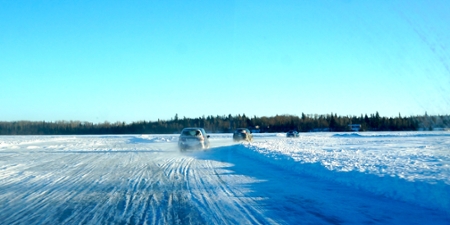
Our rescheduled January tour began at the edge of the frozen lake. We were met on the Iskatewizaagegan 39 landing by Cuyler Cotton, policy analyst for Shoal Lake 40 and a museum tour guide. We paused to look over the body of water that separated the First Nation from the mainland, and then drove cautiously behind one another for the few minutes it took to cross. We were reminded that the frozen lake in winter provides one of the most direct points of access into the community. During the other three seasons it can only be reached by crossing the water by ferry, which runs limited hours and at a cost to passengers. The short distance between the mainland and the island is the location of almost all access-related deaths.
Once across the lake, we were led to a modest community building that housed health and other social services. The front room had been transformed into a gallery space, displaying artefacts of the First Nation’s long-standing struggle for justice including newspaper clippings, photographs, correspondence with public officials, letters to the CMHR, and maps. The make-shift gallery was multipurpose: it became our home base where we assembled, talked, learned, ate lunch, and stored gear over the course of the day.
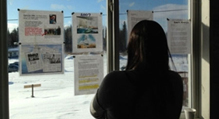
We spent time perusing the exhibits before hearing from the museum's curator Stewart Redsky and the First Nation’s Chief Erwin Redsky. Chief Redsky explain how Shoal Lake 40 became an artificial island. Both spoke about their community’s situation and efforts to make a difference. Stewart and his partner Janice also described the emotional toll of educating others about the devastating effects of forced isolation and water insecurity.
Our next stops on the museum tour would make these effects all the more tangible.
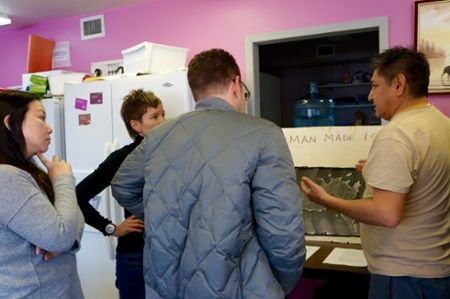
At the water container handling facility our guides demonstrated both the weight and heavy financial cost of having to haul clean drinking and cooking water into the community for daily use. “Be reminded of this when you turn on your taps at the other end of the pipe and clean water appears like magic,” they said.
Next, and with some reluctance, they brought us down the road to a provisional garbage dump. The current impossibility of transporting solid and liquid waste out of the community due to the lack of road access means that community members have little choice but to discard their waste here. Our guides described the deep regret they felt over this makeshift solution, given their sense of duty and responsibility to care for the land and water. They also pointed to the immediate impact on their own water supply and the inevitable impact that the community’s lack of proper waste disposal will have for Winnipeg’s water supply, a concern that seems lost upon federal government officials.
Then we were led on foot across the dike that diverts lower quality Falcon River water away from the aqueduct intake pipe. Stewart pointed to the frozen surface to the right of where we stood. “Under here is the clean water that goes to Winnipeg.” And then to the left, “Under here is the dirty water that Shoal Lake residents are left to draw from.” Standing on the structure that physically separated the two allowed us to visualize the discrepancy.
We continued walking along the dike until we came to a “private property sign” that barred us from going any further. The sign demarcates the land occupied by the City of Winnipeg since the federal government granted it to them in the early 1900s. The land past this point, which holds the First Nation’s historic village site and burial grounds, is barred from community members by Winnipeg’s strict security measures.
One of the final stops along the tour took CSRG members to an important site of activism for the First Nation - a temporary bridge where the community’s “Freedom Road” will be built. The road, which will span 27 kilometres to connect the community to the Trans-Canada highway is already under construction “by any means necessary.” It has been the main objective of Shoal Lake’s ongoing lobbying efforts as well as a citizen-led fundraising campaign intended to compensate for the lack of federal support for the construction. For the community the road is a matter of survival. When built it will enable safe, all-season access in and out of Shoal Lake 40 FN, as well as a means to develop local infrastructure including affordable water treatment and proper waste disposal.
Finally our tour ended back where we started at the community centre. We were invited to reflect on our experience of witnessing the devastating effects that forced isolation has had for Shoal Lake 40 FN and their territory. Many of us commented on how the tour made strikingly clear the heavy toll paid by the community for our taken-for-granted access to clean water in Winnipeg. Indeed, the curatorial strategies of the “living museum” raised our awareness of collective responsibility for Shoal Lake’s sustainability.
Over the past few years our research group has been following the developments of the Canadian Museum for Human Rights, including responses by individuals and groups who have engaged the museum and its publics through boycotts, protests and sacred fires.[3] Shoal Lake’s Museum of Canadian Human Rights Violations is a remarkable example of one such engagement. It expands conventional understandings of what a museum is and does through its innovative curation and participatory learning model, and it follows through on the promise made by many contemporary museums to provide a forum for meaningful dialogue that can lead to social change.
Angela Failler is a Chancellor’s Research Chair at the University of Winnipeg and Lead Researcher for the Cultural Studies Research Group (CSRG).
Karen Sharma is a pursuing a Master degree in Public Administration and is a member of the Cultural Studies Research Group (CSRG).
Photo credits: the authors and Peter Ives. Images reproduced with permission of Shoal Lake 40 FN’s museum organizers.[1] For more on the history of Shoal Lake 40 First Nation and Winnipeg’s water supply, see Adele Perry and Peter Ives’ recent editorial “Drinking Water Denied to Residents”.
[2] See Shoal Lake 40 First Nation’s Press Release on the opening of its Canadian Museum for Human Rights Violations.

